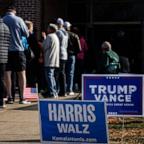
Trump and Harris are both a normal polling error away from a blowout
In 2020, polls overestimated Joe Biden's margin over then-president Donald Trump by about 4 percentage points in competitive states. The margin between Harris and Trump in 538's final polling averages of the 2024 race is 2 points or less — less than half the error from 2020 — in seven states: the familiar septet of Arizona, Georgia, Michigan, Nevada, North Carolina, Pennsylvania and Wisconsin. That means that, if the polling error from 2020 repeats itself, Trump would win all seven swing states and 312 Electoral College votes.
Of course, if the polls are off, it won't necessarily benefit Trump. The direction of polling error is impossible to predict in advance, and polls have overestimated Republicans plenty of times in the past. In a scenario where the polls overestimate Trump's margin by 4 points in every state, Harris would win all seven swing states and 319 electoral votes.
Both of these outcomes — and everything in between — are very much on the table today. But are these scenarios actually likely, or more like outside possibilities? Well, that's where the work we do for our election forecasting model can be helpful. In our final presidential forecast, Trump and Harris have nearly identical odds to win the White House.
Based on how much polls have been off in the past, our election model estimates that the average polling error in competitive states this year will be 3.8 points on the margin. In other words, the model is expecting a roughly 2020-sized polling error — although not necessarily in the same direction as 2020. (In 50% of the model's simulations, Trump beats his polls, and 50% of the time, Harris does.)
Given that all seven key swing states are so close, even small polling errors in the same direction can have a big impact on who wins the election. According to the simulations from our model, there is a 60-in-100 chance either candidate wins over 300 Electoral College votes — which Harris could do by winning five of the seven swing states and Trump six out of the seven. By modern standards, I think it's fair to consider this a blowout win — given how closely divided the country is, it's relatively unlikely for either candidate to win much more than this. (Even to get to 320 electoral votes, Trump would have to win a state like Minnesota and Harris would have to win a state like Florida.)
Of course, the probability of a blowout either way depends heavily on the popular vote outcome. This is on vivid display in the chart below, which takes all the simulations from our model and buckets them by popular vote outcome:
As you can see, Trump is favored to win the election even if he loses the popular vote by 1-2 points, which is what our national polling average currently suggests. And if the national polls turn out to be underestimating him, with Trump winning the popular vote by 1-2 points, he would be favored to win in a blowout.
Meanwhile, our model reckons Harris needs to win the popular vote by 2.1 points to be favored to win the election because swing states are more Republican-leaning than the nation as a whole. And if she wins the popular vote by 4.5 points (Biden's popular-vote margin in 2020), she is favored to win in a blowout of her own.










